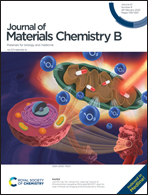Rational design of a large Stokes shift xanthene–benzothiozolium dyad for probing cysteine in mitochondria†
Abstract
Xanthene-modified cyanine dyes are considered to be an effective means to extend the emission wavelength and improve the photo-stability of cyanine dyes. However, the fluorophores obtained by this strategy generally have narrow Stokes shifts, which severely limits their application in biological imaging. Herein, a reasonable design strategy is adopted to provide an effective strategy to commendably improve the Stokes shift of xanthene–benzothiozolium fluorophores via the simultaneous expansion of a molecular π-conjugated system and heteroatomic substitution. Combined with density functional theory calculation guidance, the O atom is replaced with the S atom in the xanthene moiety and a π-conjugated benzene ring is introduced in the benzothiozolium moiety. Surprisingly, the results of the spectroscopic experiment showed that the fluorescence emission wavelength of PhCy-OH was extended to 803 nm, and the Stokes shift was improved to 68 nm. PhCy-Cys can effectively distinguish Cys from homocysteine (Hcy) and glutathione (GSH) with an extremely low detection limit of 0.166 μM. Importantly, PhCy-Cys has the ability to image endogenous Cys in mitochondria, providing the potential for exploring the specific function and mechanism of Cys in regulating oxidative stress in mitochondria.



 Please wait while we load your content...
Please wait while we load your content...